|
[Front Page] [Features] [Departments] [SGAP Home Page] [Subscribe]

The Blooming Lilly Pilly
Calder Chaffey
Introduction
The origin of the name Lilly Pilly is unknown. It seems to have been used soon after the establishment of Sydney and referred to the commonly seen white to purplish fruit born on the tree now known as Acmena smithii. In the literature there are various spellings such as 'lilly pilly' or 'lilli pilli' with or without hyphens. Significant is the use of 'll' suggesting that it may have been derived from a person's name. The "Australian Encyclopaedia" states that it is probably aboriginal. Although the name today is the common name of A.smithii, other species of the genera Acmena, Syzygium and Waterhousea are loosely called lilly pillies and this term is often included in their common names.
The fruits from these trees vary from species to species in size. colour and shape. Most are crisp. pithy, fleshy. acidic and aromatic. Many are edible, if not delectable. Although only three or four lilly pillies are used commercially in Australia many other species are marketed as fruit in SE Asia and India where they are mostly known as Jambos. In Australia lilly pillies are generally used to flavour jams and jellies.
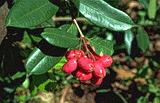 |
The typical red fruits of Syzygium australe.
Select the thumbnail image or highlighted name for a higher resolution image (28k). Photo Eric Anderson
|
 |
The flowers of this plant of Syzygium cormiflorum show "cauliflory" (ie they arise directly from the trunk of the tree).
Select the thumbnail image or highlighted name for a higher resolution image (49k). Photo: John Wrigley
|
The first recorded sighting of a lilly pilly in Australia was Syzygium paniculatum. On May 3 1770 at Botany Bay. Joseph Banks states in his journal on that date: They "found also several trees which bore fruit of the Jambosa kind, much in colour and shape resembling cherries; of these they eat plentifully and brought home also abundance, which we eat with much pleasure tho they had little to recommend them but light acid."
Jambosa is a name from Jambu. a Hindu name of the Rose Apple, Eugenia jambolana synonym Jambos. Jambos is now regarded as a synonym of Syzygium. Hyland states that the fruit of the Jambos is probably Bank's specimen 3.v.1770, the first formally described specimen of Syzygium collected in Australia and identified as Syzygium paniculatum. Hyland further found several trees growing at Towra Point, Botany Bay. which he identified as Syzygium paniculatum and he states 'I am satisfied that these trees are a natural occurrence and that this is the type locality of S.paniculatum Gaertn.'
Various explorers recorded sitings of the fruit following the establishment of the colony commencing with Captain Watkin Tench whose description was probably that of S. paniculatum. However, it was Leichhardt who recorded the greatest number of species. In a letter to Gaetano Durando, May 20th, 1846 he states that he found about five species of Eugenia while on 12th August in the same year, in a letter to Captain P. P. King, he states "you will find we met 3-4 species of Eugenia. In each case he was referring to his expedition of 1844-5. In the journal of that expedition he makes nine references to finding various species of Eugenia and to using them often as refreshing food.
Lilly Pilly Genera
Lilly-pillies are succulent-fruited trees belonging to the family Myrtaceae. This family also contains hard-fruited plants such as the genera Eucalyptus, Melaleuca (paperbarks), Callistemon (bottlebrushes), Leptospermum (tea trees) and many others.
Acmena is named after Acmene, a beautiful wood nymph from Greek, acme, the highest or best.
Eugenia is named in honour of Prince Eugene of Savoy, 1663-1736. who was born in Paris and became an Austrian general. It is a genus of trees and shrubs widely distributed through the tropical regions of the world finding its greatest development in America with a few outliers in Asia, Australia, New Guinea and the western Pacific. In a broad sense, Eugenia embraces probably 1000 species. There is still a strong difference of opinion among botanists, however, as to the limits of this genus; though most now hold to the view that the Asiatic, Australian and Pacific trees, previously placed under Eugenia, should be divided into four distinct genera. These are Eugenia, in a restricted sense, Acmena, Cleistocalyx, and Syzygium. Under this arrangement Eugenia is represented in Australia by only one species, E.reinwardtiana, of tropical or near-tropical Queensland.
Cleistocalyx, from Greek, kleistos, closed, refers to the calyx forming a cap or calyptra (operculum) which detaches at maturity. Some botanists have placed two Australian species in the genus Cleistocalyx because they both have calyptrate calyces. However, these species are not closely related and there are calyptrate species in the genus Syzygium whose closest relatives are not calyptrate. Because of this most botanists place them in the genus Syzygium.
Syzygium, from Greek, syzygos, joined, refers to the paired leaves of Calyptranthes suzygium, a Jamaican plant for which the name was first used. This is the largest genus of lilly pillies represented in Australia. Nearly all are found in the rainforests of Queensland and New South Wales. Some are very large trees, one of the largest being S.francisii.
 |
The deep red flower clusters of Syzygium wilsonii may be over 10 cm in diameter.
Select the thumbnail image or highlighted name for a higher resolution image (33k).
|
Waterhousea, honours Dr J. Waterhouse, a botanist who made an extensive study of the genus.
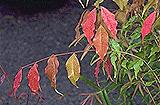 |
The brilliant colour of the new growth on Waterhousea unipunctata is as spectacular as any flower.
Select the thumbnail image or highlighted name for a higher resolution image (39k).
|
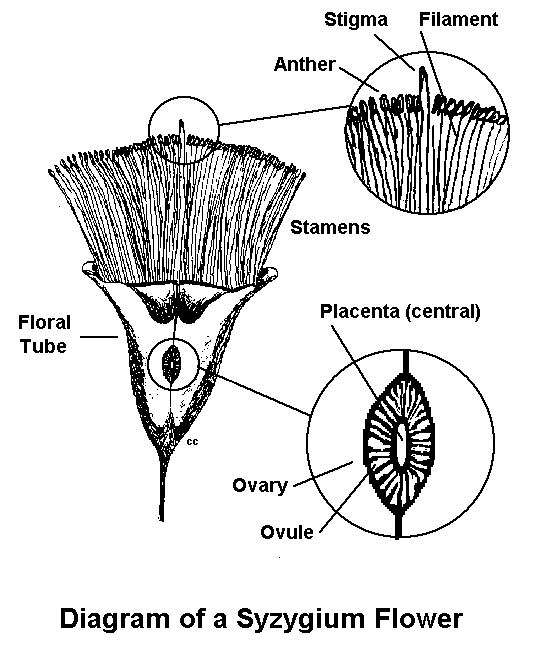
Characteristics
The following features are confined to and characteristic of lilly pillies:
Trunks often have buttress roots at the base.
Bark is rough, often scaly and grey or brown-grey coloured.
 |
Twigs of the newest growth are often angled, i.e. in cross section they are square to rectangular. Sometimes the sides of the twigs may be drawn out into wing-like membranes, e.g. S.australe.
Leaves are opposite, i.e. each pair of leaves join the stem opposite each other. They are discolorous being usually darker on the upper surface and lighter beneath. Veins are rib-like structures within the leaves. There is a central vein or panicles running from the leaf stem to the tip. Joining this are lateral veins which run from the midrib on either side towards the leaf margins. The number of pairs and the angle at which they join the midrib is often characteristic of each species and helps in identification. An intramarginal vein is usually found around the leaf just inside the margin. Its distance from the margin is also helpful for species identification.
Oil dots are present in the leaves of most species. These are tiny round translucent bead-like structures within the leaf tissue which can usually only be seen by holding the leaf to the light and looking through it with a magnifying lens. Occasionally they are obvious enough to see with the naked eye. They lie between the lateral veins and their size and number present is specific for each species and may be used as another characteristic for identification. Leaf shapes are characteristic of the species.
|
 |
Flowers are in panicles, i.e. in clusters on stems which branch and rebranch from the main stem. These panicles are terminal, arising at the ends of leaf-bearing stems where they project well beyond the leaves. They may also arise from axils, i.e. the angle between leaf stalks and the stems from which they arise.
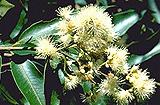 |
Leaves and flowers of Waterhousea floribunda. In the higher resolution image leaf galls caused by thrips can be seen below the flowers.
Select the thumbnail image or highlighted name for a higher resolution image (46k). Photo: John Wrigley
|
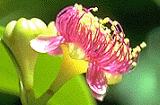 |
The flowers of Syzygium papyraceum show the clusters of stamens surrounding the central style.
Select the thumbnail image or highlighted name for a higher resolution image (31k). Photo: John Wrigley
|
Anthers are the pollen-bearing swellings on the ends of stamens, the filament-like structures which give the flowers their characteristic pincushion appearance. Anthers are divided into lobes which are parallel in Syzygium and Waterhousea, divergent or at an angle to each other in Acmena. They contain pollen within and on maturity split to liberate it for fertilisation Petals lie on a rim beneath the stamens and are very small, usually 2-5 mm in diameter.
The style, a long thicker stem-like structure, is situated in the centre of the mass of stamens. It is connected to the ovary below and its upper end is below the level of the anthers in Acmena and Waterhousea, level with or just above in Syzygium. Fertilisation takes place when a pollen grain placed on the upper end of the style grows a long process down through the style tissue to the ovary and reaches an ovum or egg-cell. The ovary is inferior meaning that it is below the attachment of the lower ends of the stamens. This rim of attachment, the calyx rim, is left as the umbilicus-like structure on the bottom of the fruit.
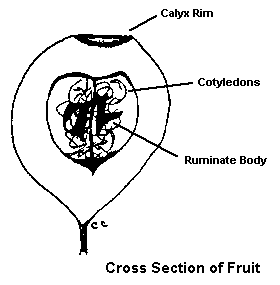 
Fruits are succulent or fleshy and usually contain one seed except in Syzygium paniculatum. The seeds have two cotyledons which, on germination, become the first two leaves of the new plant. These may easily be separated in the seeds of Syzygium but remain tightly fused at the apex in Acmena seeds and at the base in Waterhousea by an infiltrating oily body of tissue. Seeds having this oily tissue structure, i.e. an intercotyledonary inclusion, are called ruminate.
Propagating lilly pillies
All lilly pilly species have fleshy fruits in which the seeds are embedded. Many species are found delectable by a variety of grubs which eat the fruit and seed. Seeds of many species are short lived. The flesh is prone to infection by moulds which also invade the seeds. These factors all effect the viability of the seeds. Fruits should be collected as soon as they are ripe and the seeds separated from the flesh. This may be a tedious business especially with small fruited varieties. An easier way to perform the seed extraction is to first ferment the fruit by moistening and placing in a sealed plastic bag in the sun for a couple of weeks. Most of the grubs seem to be drowned by fluid produced by this process and fermentation of the flesh makes separation easier. Some people merely soak the fruit in a bucket of water for a few days which seems to effectively drown the grubs while others plant the fruit whole without bothering to remove the seeds. Results of these short-cut methods are inconsistent and not to be recommended.
After recovery, the seeds should be planted immediately in a seed raising mixture and covered to a depth of about their diameter. Keep moist. Germination may take up to several months.
Propagation by striking cuttings is successful with some species such as S.australe but may be very difficult with others. Use fresh, semi-mature slips about 75-100 mm in length taken from the top of the trees and pot up in a mixture of coarse sand 75% with peat moss 25%. Plant several in each pot, water and cover with a plastic bag until they have rooted, usually about three to four weeks. Early spring is the best time to strike cuttings. Fleshy stemmed lilly pilly species seem easiest to strike.
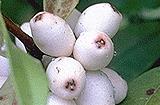 |
Fruits of Syzygium wilsonii showing the calyx-rim scar on the base of each fruit.
Select the thumbnail image or highlighted name for a higher resolution image (31k). Photo: John Wrigley
|
This article is the introductory chapter from "The Blooming Lilly Pilly, by Calder Chaffey and published by the Far North Coast Group of the Australian Plants Society (NSW). A review of the book was published in the June issue of "Australian Plants online".
Copies are available for $AU8.50 inc. postage within Australia from P.O. Box 4083 Goonellabah, NSW, 2480.

[Front Page] [Features] [Departments] [SGAP Home Page] [Subscribe]
Australian Plants online - September 1999
The Society for Growing Australian Plants
|